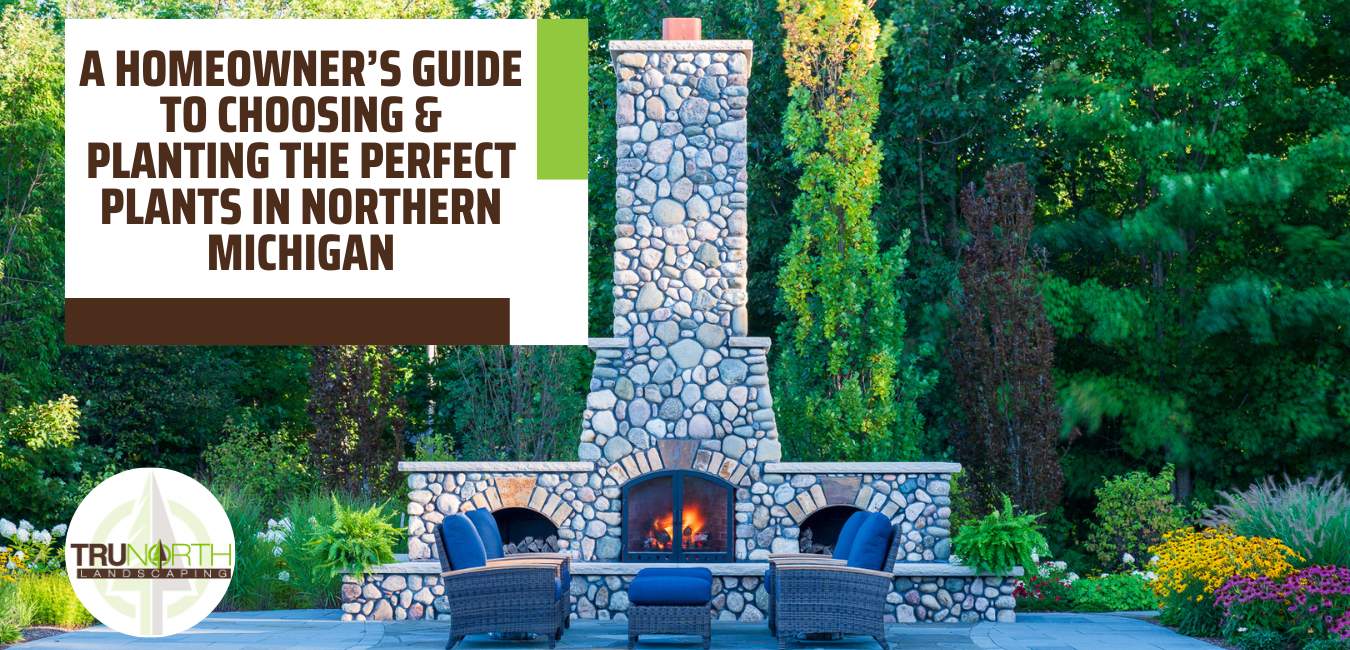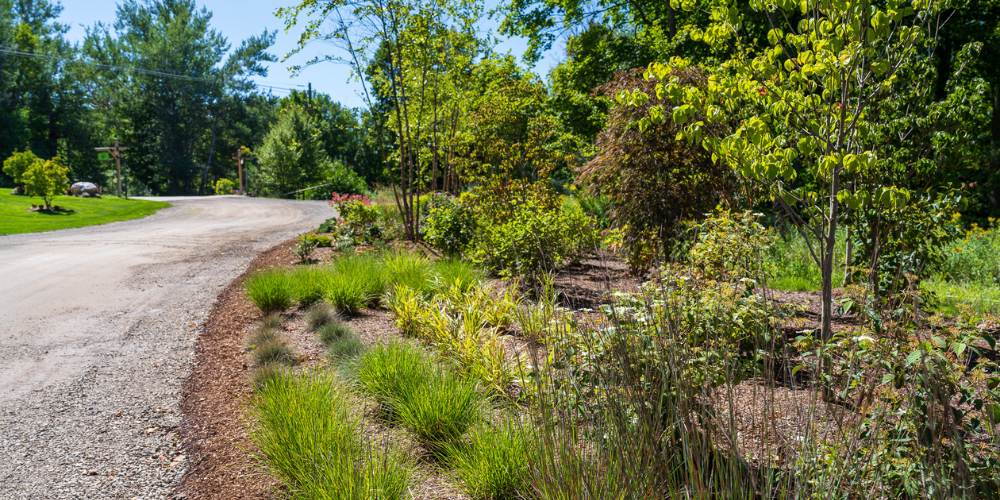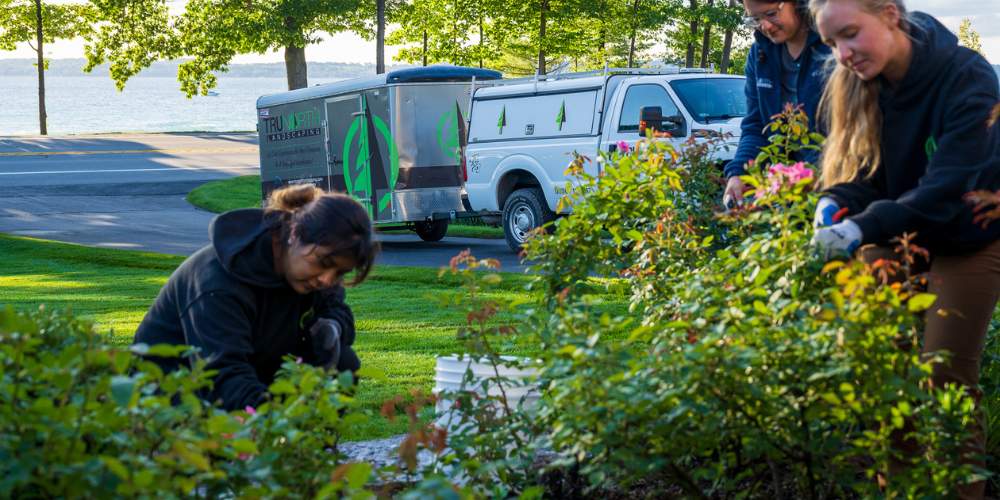
So, you’ve just completed a stunning new hardscape and are now ready to bring your garden to life with vibrant plantings. But with all the options out there, how do you pick the perfect ones for your Northern Michigan landscape?
The key to a successful garden lies in more than just picking some pretty plants; it starts with understanding their specific needs and careful planning. Plants are more than just decorative elements—they are the finishing touch that brings your outdoor space together, creating a welcoming environment.
Let’s explore how to choose plants for Northern Michigan, timing considerations when planting, and some essential maintenance tips so you can successfully plant a new garden area.
Considerations for Choosing Plants
Choosing the right plants for your Northern Michigan landscape involves more than just picking out your favorites. With literally thousands of plant varieties available, let’s look at what you need to consider to ensure your garden thrives.

Deer and Rabbit Resistance
In the Grand Traverse and Leelanau County areas, deer and rabbits can be significant pests in the garden. They tend to graze on various plants, which can lead to frustrating damage. If you know that deer or rabbits are a problem at your home, be sure to consult with experts before purchasing plants.
To avoid plant damage, select plants that are known to be resistant or at least deterrent to these critters. For deer resistance, look for plants with strong scents or tough leaves, such as lavender or ornamental grasses. For rabbits, consider plants like marigolds or peonies that they typically avoid.

Sun, Shade, and Water Needs
Understanding the light conditions in your garden area is crucial for plant selection. As the landscape in Northern Michigan varies greatly, your property may experience a range of sunlight conditions, from full sun to deep shade. Choose plants based on the specific light exposure of your garden spaces.
- Full Sun: Plants that thrive in full sun need at least 6 hours of direct sunlight each day. Examples include coneflowers, daylilies, and black-eyed Susans.
- Partial Shade: These plants do well with filtered sunlight or a few hours of direct sunlight. Consider hostas or astilbes.
- Full Shade: For areas with little to no direct sunlight, opt for shade-loving plants like ferns and hostas.
Different plants also have varying water requirements. Matching plants to your garden’s water availability can prevent overwatering or drought stress. Consider if you have an irrigation system you plant to utilize or will rely on natural rainfall. Choose drought-tolerant plants such as sedums, lavender, and ornamental grasses if your garden area has limited water availability. Plants like astilbe and daylily require more frequent watering and are ideal for areas with better water access.

Type of Soil
Soil quality can greatly impact plant health and growth. In Northern Michigan, our soil is typically known to be sandy. This means water drains quickly through the soil. For this reason, it can be wise to select plants that prefer well-drained soil. If you have existing plantings that are struggling, your soil could be part of the problem. Consider adding soil amendments to areas that are especially sandy to help give plantings the nutrients they need.
The Best Time to Plant in Northern Michigan
Timing is everything when it comes to planting in Northern Michigan. To ensure your plants establish well and thrive, it’s important to choose the right time of year and consider the bloom times of perennials as well. Here’s a guide to help you make the most of your planting efforts:
Spring Planting:
Spring is an ideal time to plant many types of perennials and shrubs. The soil is warming up, which encourages root growth, and there’s usually ample rainfall to help your new plants settle in. Aim to plant as soon as the soil is workable, typically May to early June. Spring planting allows plants to establish strong roots before the heat of summer arrives.
- Perennials to Plant in Spring: Consider planting Spring-blooming perennials such as bleeding hearts, peonies, and primroses. These plants will start to show their colors as early as late Spring and will benefit from the full growing season to establish themselves.

Summer Planting:
Summer planting is best suited for warm-season plants that can handle the higher temperatures. While summer is less ideal for planting due to potential heat stress, it’s a good time to plant annuals, vegetables, and some hardy perennials if you provide adequate watering and shade.
- Perennials to Plant in Summer: For late Summer planting, choose perennials like coneflowers, daylilies, and black-eyed Susans that will establish quickly and bloom in late Summer.
Fall Planting:
Fall is another excellent time to plant, especially for perennials and shrubs. The cooler temperatures and increased rainfall help reduce stress on newly planted specimens. Planting in late summer to early fall, from mid-August to mid-October allows plants to develop strong root systems before winter sets in.
- Perennials to Plant in Fall: Autumn is the perfect time for planting Fall-blooming perennials like chrysanthemums, asters, and sedums. These plants will add color to your garden as the growing season winds down and will be well-established by the time Spring arrives.
When planning your garden, think about the bloom times of perennials to ensure continuous color throughout the growing season. For example, you may want to combine early bloomers like tulips and daffodils with summer favorites like lavender and black-eyed Sussans, and finish with fall varieties like chrysanthemums. This approach ensures that your garden remains vibrant and interesting from Spring through Fall.

Remember Maintenance Requirements
Once you’ve selected and planted the perfect plants for your Traverse City area garden, maintain them is key to ensuring their continued health and beauty. Here’s a look at the essential maintenances tasks:
- Mulching: Mulching is a vital maintenance task that offers many benefits to your garden. Applying a layer of mulch around your plants helps retain soil moisture, regulates soil temperature, and suppresses weeds. Aim to apply mulch in the Spring.
- Watering New Plantings: Newly planted trees, shrubs, and perennials require consistent watering to establish their root systems. During the first growing season, water your new plantings deeply and regularly, especially during dry spells.
- Deadheading and Pruning: Deadheading, or removing spent flowers, encourages plants to produce more blooms and keeps your garden looking neat. Regularly inspect your plants and remove any dead or faded flowers. Pruning is also important for maintaining the shape and health of shrubs and trees.
- Weeding: Weeds compete with your plants for nutrients, water, and sunlight. Regular weeding is necessary to prevent weeds from overtaking your garden. Hand-pulling weeds or using mulch to suppress them can be helpful as well. Be sure to address weeds early before they have a chance to establish deep roots.
If the thought of ongoing maintenance tasks feels overwhelming, or if you simply prefer to leave it to the experts, consider enlisting professional landscaping services. Horticulture services, such as weeding and pruning, are often included in full-service landscape maintenance plans to help your entire property look its best.

Partnering with a Professional for Landscape Design and Maintenance
Selecting and planting the perfect plants for your garden can feel like a monumental task. With so many factors to consider—like choosing plants with varying textures, colors, and heights, and ensuring they fit the specific conditions of your Northern Michigan garden—it’s easy to feel a bit overwhelmed.
From understanding the idea conditions for sun, shade, and water, to timing your plantings and keeping up with ongoing maintenance, there’s a lot that goes into creating a beautiful and thriving garden. If this process ends up feeling too daunting, our team of experts is here to help you every step of the way—from selecting the perfect plants to designing an ideal layout to handling all the maintenance tasks that keep your garden looking its best.
Let us take the stress out of planting and maintaining your garden so you can enjoy the flourishing landscape you’ve always dreamed of.
Ready to get started designing and planting your landscape or just need some help with plant maintenance? Get started today by filling out our contact form!
Image Source: all images property of TruNorth Landscaping
Get started today with a consultation!
Want tips and tricks for your lawn & landscaping?
Sign Up For Our Free Quarterly Newsletter
We take your personal information very seriously. We will not share any of the information you provide with any 3rd parties. Provided information will be used specifically to contact you in regards to your inquiry.
